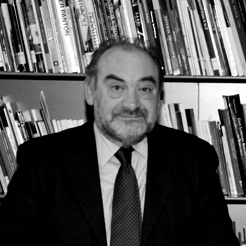
Mauro Civai
Director of the Civic Museum of Siena

Director of the Civic Museum of Siena
Santini most probably matured this project during one of his frequent trips between Siena and Avignon. He has been, in fact, among the most assiduous and enthusiastic protagonists of the twinning between the two ancient cities for many years now and probably has more and closer friends in Provence than in Tuscany. If he had mentioned his idea to me, I would probably have tried to discourage him, holding that his artistic style was a little too remote and not flexible enough for the illuminated mysticism of Catherine of Siena and her life pervaded by an incandescent, uninterrupted flow of spiritual passion. But this time - and I'm happy to admit it - I've made a big mistake.
The panels that Enzo Santini has painted with deeply spiritual toil and dedicated to Catherine, show off his technical mastery that is by now full and mature but, still more, reveal an interior, restless and inexhaustible search for freezing forms that, through an ample sentimental acknowledgment, were able to hold a power of enchantment similar to that possessed by the Sienese Saint. Catherine lived her life simply like a breath of spring breeze, but her experience and deeds shook the way of thinking of her contemporaries to the roots. The miracle of Catherine lies here in this apparent contrast, between the delicate fragility of her body and the devastating energy of her spirit that, combined in an explosive mixture, brought about achievements of incalculable importance and sewed the seeds far plants that flourish and are fertile up to this day.
Santini's cycle, in my opinion, manages to illustrated the dichotomy between these contrasting aspects: the encumbrance of the body, the weight of temptation and the titanic farce of ascension towards a crystalline purity, not achieved by means of ideological development, but filtered by the awareness of the suffering of men. Of mankind. There have recently been discussions at Siena concerning sacred art, whether it was alive or dead or, more importantly, whether it could be justified and proposed at the present time that is very poor in spiritual tension. Even if we begin from the awareness that all art, if it is really art, contains an intrinsic sacred value as it is a privileged message, more directly addressed to the heart of people, we must also consider that certain works, due to the subject they deal with, the singular context in which they are produced and the specific public to which they are aimed, occupy a place of pride in this particular sector.
The work of Santini is a perfect example of this, because with his impalpable transparency and through his sidereal atmospheres, he manages to be the intermediary of a very profound message and opens doors that lead to impervious and unconsoled paths that must, however, be travelled along.
Santini's exhibition on Saint Catherine of Siena will now travel round the world to prove that Sienese culture continues its ages old fertility.